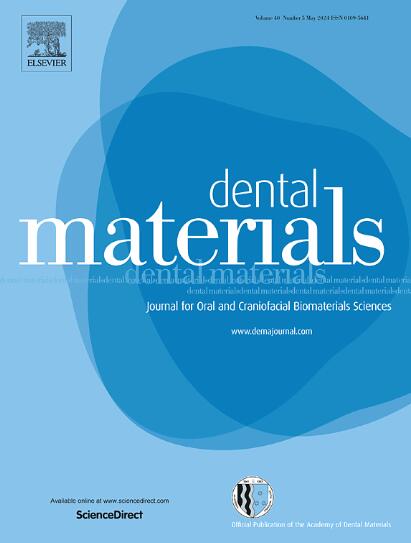多西环素纤维微粒作为蚀刻-冲洗胶粘剂系统的治疗成分:对牙本质的光学、物理和粘合性能的影响。
IF 6.3
1区 医学
Q1 DENTISTRY, ORAL SURGERY & MEDICINE
引用次数: 0
摘要
目的:评价用纤维颗粒修饰蚀刻冲洗(ER)粘接剂系统,加或不加强力霉素(DOX)作为治疗成分的效果。方法:以聚- ε-己内酯(PCL)为原料,以10 wt%的聚合物溶液为原料,采用静电纺丝法合成聚合物纤维。将PCL溶液分成两份:一份保持不变,另一份加入25% wt%的DOX。每个静电纺丝纤维垫在低温冲击磨机中进一步加工以获得小尺寸纤维颗粒,并对其进行形态学,化学(FTIR)和抗菌活性(对变形链球菌和乳酸菌)分析。将两步ER粘合剂one -step (Bisco)分成三等分:一等分不加修饰,作为未填充的对照,另外两等分加入20 wt%的DOX或PCL纤维微粒。在立即测试和水储存一年后,测试纤维改性胶粘剂的转化率(DC)、光学性能(颜色变化[ΔE00]、半透明性和折射率[RI])、润湿性和与牙本质的粘合潜力(微拉伸粘合强度/µTBS)。采用方差分析和Kruskal-Wallis检验,α= 5 %。并用威布尔分析对粘结强度数据进行了分析。结果:PCL和DOX颗粒形态呈非均匀的直径分布,两者相似。PCL颗粒对变形链球菌和乳杆菌的生长没有抑制作用,而DOX颗粒对变形链球菌和乳杆菌的抑制作用明显大于氯己定(对照)。纤维颗粒掺入粘合剂改变了材料的颜色外观(ΔE00>1.8 -高于可接受阈值);只有PCL胶粘剂的半透明性略有降低,各测试胶粘剂的RI相似。意义:纤维颗粒的掺入,特别是那些基于治疗性化合物的纤维颗粒,如多西环素,是提高蚀刻-冲洗胶粘剂系统对牙本质的生物和润湿能力的一种选择。此外,随着时间的推移,纤维颗粒的存在有助于稳定的树脂-牙本质键。本文章由计算机程序翻译,如有差异,请以英文原文为准。
Doxycycline-laden fibrous microparticles as a therapeutic ingredient for etch-and-rinse adhesive systems: Effects on optical, physical and bonding properties to dentin
Objectives
To evaluate the effects of the modification of an etch-and-rinse (ER) adhesive system with fibrous particles with or without doxycycline (DOX) as a therapeutic ingredient.
Methods
Polymeric fibers were synthesized via electrospinning using a 10 wt% polymer solution based on poly-(ε-caprolactone) (PCL). The PCL solution was separated into two aliquots: one was kept unchanged, and the other was laden with 25 wt% of DOX. Each electrospun fiber mat was further processed in a cryogenic impact mill to obtain small-sized fibrous particles, which were characterized with morphological, chemical (FTIR), and antibacterial activity (against Streptococcus mutans and Lactobacillus) analyses. The 2-step ER adhesive One-Step (Bisco) was separated into three aliquots: one was kept unmodified to serve as an unfilled control, and the other two aliquots were added with 20 wt% of DOX or PCL fibrous microparticles. The fiber-modified adhesives were tested for degree of conversion (DC), optical properties (color change [ΔE00], translucency, and refractive index [RI]), wettability properties, and bonding potential (microtensile bond strength/µTBS) to dentin after immediate testing and one-year of water storage. The data were statistically analyzed using ANOVA and Kruskal-Wallis tests with α= 5 %. The bond strength data was also analyzed using Weibull analysis.
Results
The morphology of the PCL and DOX particles demonstrated a nonuniform diameter distribution similar to each other. While the PCL particles did not inhibit the growth of S. mutans and Lactobacillus, the DOX particles resulted in significant inhibition halos greater than chlorhexidine (control). The incorporation of the fibrous particles into the adhesive altered the color appearance of the material (ΔE00>1.8 – above the acceptability threshold); translucency was slightly reduced only in the PCL adhesive, and the RI was similar among the tested adhesives. DC was similar among the adhesive groups, but their wetting ability increased in the following order: Control (42.7°±5.1°) < PCL (35.3°±3.4°) < DOX (28.9°±3.3°). All adhesives resulted in similar μTBS after 24 hours of water storage, but after one year of storage, the resin-dentin bonds obtained with DOX adhesive were greater than the control and stable over time. The characteristic strength of the resin-dentin bonds created with the DOX adhesive was as stronger than that obtained with the unmodified control.
Significance
The incorporation of fibrous particles, especially those based on therapeutic compounds like doxycycline, is an alternative to improve the biological and wetting ability of etch-and-rinse adhesive systems to dentin. Also, the presence of fibrous particles contributed to stable resin-dentin bonds over time.
求助全文
通过发布文献求助,成功后即可免费获取论文全文。
去求助
来源期刊

Dental Materials
工程技术-材料科学:生物材料
CiteScore
9.80
自引率
10.00%
发文量
290
审稿时长
67 days
期刊介绍:
Dental Materials publishes original research, review articles, and short communications.
Academy of Dental Materials members click here to register for free access to Dental Materials online.
The principal aim of Dental Materials is to promote rapid communication of scientific information between academia, industry, and the dental practitioner. Original Manuscripts on clinical and laboratory research of basic and applied character which focus on the properties or performance of dental materials or the reaction of host tissues to materials are given priority publication. Other acceptable topics include application technology in clinical dentistry and dental laboratory technology.
Comprehensive reviews and editorial commentaries on pertinent subjects will be considered.
 求助内容:
求助内容: 应助结果提醒方式:
应助结果提醒方式:


